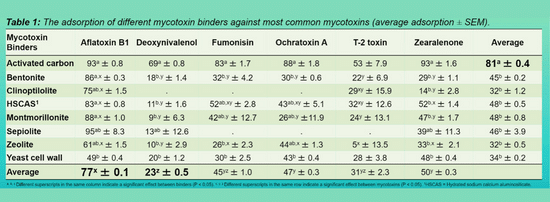Mycotoxin binders (MTB) work by chemical interactions involving cation exchange capacity with various types of bonds and by their physical structure serving as a “net” to in essence “trap” mycotoxin molecules. The bonding and structural properties of traditional MTB also enable these ingredients to tie-up amino acids and vitamins. Understanding the risks and benefits associated with MTB allows nutritionists to determine the economic feasibility of these ingredients.

Lab-generated in vitro results offer in vivo implications to be considered during ration formulation. Further, the in vitro projects enable new product development and evaluation of modes-of-action. The in vitro research projects included in Kihal et al. (2020, 2021) sought to start to understand how common MTB interact with mycotoxins and dietary nutrients. Using a washout model at multiple pH levels to simulate ruminal and lower tract digestion, both peer-reviewed papers show the effectiveness of different MTB at binding different mycotoxins and nutrients. Each test tube contained one binder and one mycotoxin or nutrient, or sometimes multiple nutrients. Because the animal’s digestive tract is populated by microbes and contains all the nutrients she eats we cannot use the results quantitatively. But what the research does tell us is which mycotoxins and nutrients the MTB may bind in the cow if the opportunity is right.
What do the in vitro Kihal studies tell us about the interaction between MTB and nutrients, including vitamin E, vitamin D, and the B-vitamins 1, 2, 3 and 6, as well as the amino acids methionine, lysine and threonine? The MTB did not bind vitamin D effectively, but 15-60% of the vitamin E was bound by various MTB. An average of 20% of the amino acids were bound by MTB, and yeast cell wall bound the most amino acids at 25% of each. B vitamin binding varied from 0-95% depending on the B vitamin and the MTB.
What does the 68-study meta-analysis in Kihal et al. (2022) tell us about MTB and mycotoxins? One thing is certain – binders are effective at binding aflatoxin. The unfortunate part is we do not see much aflatoxin in the United States anymore. At best, some MTB may bind up to 50% of zearalenone, fumonison, and T2 in vitro, but varies from 5-50%. The MTB have little efficacy against DON, binding 10-20%. What binding efficacy can we expect in the cow, when the MTB are not alone with the mycotoxin as in an in vitro situation?
The Kihal et al. series of research articles (2020, 2021 and 2022) serve as clear indicators that MTB are often more effective at tying up nutrients than protecting the animal against mycotoxins. The research documents enable a nutritionist to rank and make ration adjustments for including various MTB in the diet due to reduced nutrient availability. In contrast, the DTX™ is not a MTB, does not tie-up nutrients and is research proven for the ability to defend and protect lactating dairy cows against DON and zearalenone.
Authors: Agrarian Solutions: Larry Roth, Ph.D., PAS – Vice President of Nutrition and Caroline Knoblock, MSc, – Director of Nutrition, Agrarian Solutions
